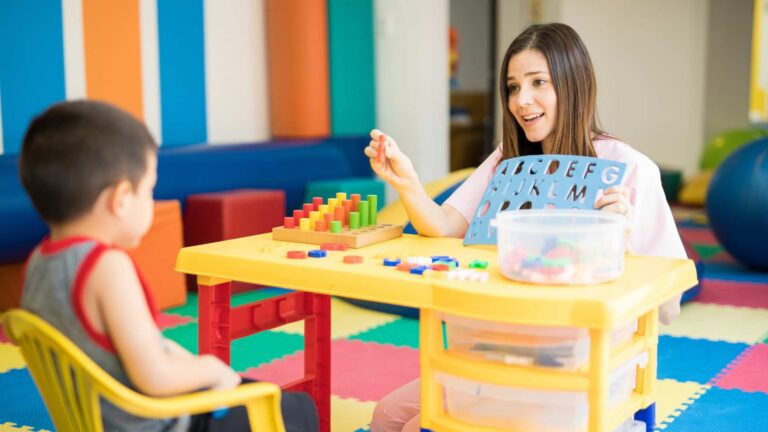Throughout autism’s extensive history, experts have pursued the existence of an autism cure. While their efforts never derived from bad intentions, it’s time to acknowledge that the concept of a cure for autism belongs to the past, a belief formed before our society truly grasped that autism is not a disease.
Numerous studies have made valiant attempts to pinpoint a singular cause that could explain this intricate condition, yet they’ve all fallen short. Autism is complex, and each individual on the spectrum is unique in their diagnosis, making it challenging to uncover a universal cause. To complicate matters further, our understanding of the human brain remains in its infancy.
At Texas ABA Centers, we firmly keep ourselves well-informed and up-to-date with the scientific understanding of autism and its treatment. This blog will delve into the research that debunks the myth of a cure for autism while highlighting the best ways to limit its detriment on individuals.
If Autism Isn’t a Disease, Then What is It?
It’s essential to understand that there is no cure for autism since autism itself is not an affliction. Instead, autism spectrum disorder (ASD) is a developmental condition that shapes an individual’s social skills, communication, behavior, and connection with the world. This condition arises from the diverse development of the brain, resulting in a wide range of symptoms, all scattered along a spectrum. From subtle behavioral quirks to more pronounced challenges, autism doesn’t fit a one-size-fits-all mold.
What Causes Autism?
Autism, with its vast array of behaviors and challenges, is complicated to categorize when identifying its root causes. The complexities of the disorder make it challenging to pinpoint a single, definitive cause. The spectrum encompasses individuals who might struggle with communication while others remain entirely non-verbal. To shed light on what factors can contribute to the development of autism in children and infants, we’ll delve into some of the more frequently cited reasons:
1. Genetics – One heavily researched cause of autism lies in genetics, such as this study conducted by the National Library of Medicine. Studies involving twins have shed light on the substantial role of genetic inheritance in determining whether a child will land on the spectrum. Research indicates that the heritability of ASD falls within the range of 60-90 percent.
However, it’s not straightforward to only point to familial lines. In some instances, autism appears without any family history of the condition. In these cases, scientists believe spontaneous mutations in either the father’s sperm or the mother’s eggs might be responsible. One supporting evidence for this theory is the increased risk of autism in children born to older fathers, as extended paternal age provides more opportunities for genetic mutations.
2. Environmental Factors – Beyond genetics, environmental factors may also affect autism development. Researchers, like those at the National Institute of Environmental Health Sciences, have investigated potential triggers, including exposure to pesticides, plastics, and various heavy metals such as mercury and lead. Additionally, prenatal factors, such as maternal diabetes, the use of psychiatric medications, and instances of hypoxia (oxygen deprivation) during pregnancy due to conditions like sleep apnea, could also contribute to the risk.
3. Anecdotal Claims – Postnatal factors have arisen in the recent media landscape as potential contributors to autism. These include concerns like vaccinations, gastrointestinal issues, and autoimmune disorders. However, it’s important to note that evidence supporting these theories has been primarily anecdotal, with few substantiated claims. Most of these theories derive from falsified or misunderstood information.
What Are the Community’s Thoughts on a Cure for autism?
Amidst the ongoing quest for a cure for autism, we must consider the thoughts of the autism community. Many adults with autism do not see their condition as needing a cure. They view their neurodiversity as integral to who they are, shaping their unique perspectives and strengths. These individuals argue that their differences are valuable and unique. The neurodiversity movement advocates for celebrating and accommodating neurological differences instead of seeking a cure, a notion embraced by a significant portion of the autism community. The focus should be on creating an inclusive world where individuals with autism can thrive on their own terms.
Families and advocates within the autism community are also integral voices in this discourse. While some may actively seek therapies to address specific challenges associated with autism, an increasing number believe that a cure is not the ultimate goal. Instead, they concentrate on supporting individuals with autism to lead fulfilling lives by improving access to education, employment, healthcare, and social opportunities. Their emphasis is on enhancing the quality of life for people with autism, regardless of whether experts ever discover a cure.
What Are the Genetic Mutations That May Cause Autism?
As mentioned above, atypical brain development may severely impact autism’s likelihood, influenced by an intricate interplay of over 1000 genes. Yet, the genetic landscape of autism is much like an iceberg – we’ve explored merely the tip. Some genes that potentially entwine with autism include:
- SHANK3 – Nestled on chromosome 22, this gene is a prominent candidate closely associated with autism. Its role is to code for a protein responsible for nurturing and preserving synapses, the neural connections. Any mutations within SHANK3 amplify the risk of autism significantly.
- CNTNAP2 – A pivotal player in synapse formation and developing language and communication skills, CNTNAP2 is at the core of the autism landscape. Mutations in this gene set the stage for an increased risk of autism and language impairments.
- NRXN1 – This gene orchestrates the synthesis of a protein vital for synapse formation. A twist in NRXN1 significantly elevates the autism risk.
- CHD8 – As a genetic gatekeeper of gene expression and brain development, CHD8’s mutations have emerged as strong contenders in augmenting autism risk.
- TSC1 and TSC2 – These genes regulate cell growth and division. Mutations here can lead to Tuberous Sclerosis, a condition interwoven with a heightened risk of autism.
Genetic exploration is still in its infancy. While experts have identified the links between these genes and autism, the intricacies of these connections remain elusive. The precise manifestations and how the alteration of a single gene may impact development are still ambiguous. This complexity expresses the need to consider environmental factors potentially influencing gene expression. Thus, the quest for an autism cure, though advancing, has yet to unveil the coveted solution.
What is ABA Therapy for Autism?
A cure for autism may not exist or need to exist, but many interventions can help these individuals live impactful lives. Among the many, the one that stands out as the most effective is Applied Behavior Analysis (ABA) therapy. This intervention aims to teach those on the spectrum valuable skills and behaviors to help them in all aspects of their life, such as social engagement, academics, relationships, and other vital areas.
This evidence-based approach to autism treatment can give children and teens with autism the skill sets they need to achieve independence and autonomy. ABA does not want to cure someone of autism; instead, experts analyze an individual’s strengths and weaknesses to create a tailored plan that gives them the best chance of success. It also aims to reduce challenging behaviors in autism, like aggression and self-harm.
Get Started at Texas ABA Centers
Texas ABA Centers provides individualized ABA therapy for children and teens on the spectrum. Our comprehensive plans focus on specific strengths, weaknesses, and needs. Our services include clinic-based and in-home ABA therapy options to accommodate your schedule. No matter which challenges your loved one may face, we can help.
Call (877) 771-5725 or fill out the contact form on our website for additional information.








